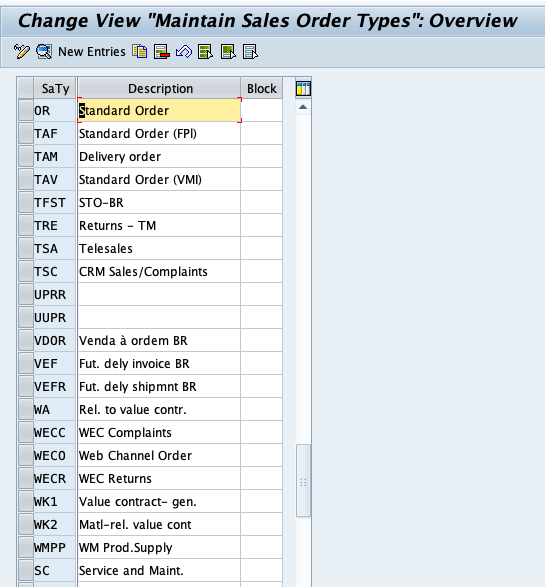In the SAP Sales and Distribution (SAP SD) module, sales document types are pivotal in managing and processing sales and customer distribution data. These Sales document type in SAP Sd define the various stages and characteristics of sales transactions, such as inquiries, quotations, sales orders, and more. Understanding these document types and their application in real-world scenarios is essential for effective SAP SD management.
Structure of Sales Document Type in SAP SD
In SAP SD, the structure of a sales document is crucial for effective sales management. It can be divided into three essential parts:
1. Header Data: Header data applies to all line items within the sales document which includes customer information. The header contains general data about the sales document, such as the document type, sales area (sales organization, distribution channel, division), and the date of the transaction.
- The sources of header data include:
- Customer master records.
- Control data from the enterprise structure
- Certain configuration data.
- Header data is controlled by document types, and its storage table is [VBAK].
2. Item Data : Item data in pertains to specific line items within the sales document which include material-related information. This level details each item in the sales order, including product specifications, quantities, and pricing.
- The sources of item data include:
- Material master records
- Customer Material Information Records (CMIR).
- Some aspects of control data
- Certain configuration data
- Item data is controlled by item categories, and its storage table is [VBAP].
3. Schedule Line Data: Schedule line data comprises delivery dates and confirmed quantity details.
- The sole source of schedule line data is configuration data.
- Schedule line data is controlled by schedule line categories, and its storage table is [VBEP].
Different Sales Document Types in SAP SD
Sales document types in SAP SD are templates that define the processing of various sales transactions. They determine the kind of sale, such as standard orders, rush orders, or returns, and are pivotal in managing the sales lifecycle. Each document type has unique properties and serves a specific purpose in the sales process.
To view and configure the various Sales Document Types in SAP SD, use Transaction Code VOV8. The image showcases the “Change View: Maintain Sales Order Types” screen, listing document types like Standard Order (OR), Delivery Order (TAM), Returns (TRE), and more. This tool enables efficient customization of sales processes to suit business needs.

Key SAP SD Sales Document Types
- Standard Orders (OR): The most common type, used for regular sales orders.
- Rush Orders (RO): For urgent orders that require immediate delivery.
- Returns (RE): Used when customers return products.
- Credit Memo (CR): Issued to credit a customer’s account.
- Debit Memo (DR): For charging additional amounts to a customer.
- Contract (KC): A longer-term agreement with a customer for supplying goods or services.
| Process
| Document Type | T-Code
|
| Enquiry
| IN
| VA11
|
| Quotation
| QT
| VA21
|
| Order
| OR
| VA01
|
| Rush Order
| RO
| VA01
|
| Cash Sale
| CS
| Do
|
| Returns
| RE
| Do
|
| Credit memo request
| CR
| Do
|
| Debit memo request
| DR
| Do
|
| Invoice collecting request
| RK
| Do
|
| Free of charge
| FD
| VA01
|
| Subsequent delivery free of charge
| SDF
| Do
|
| Consignment fill up
| CF
| Do
|
| Consignment issue
| CI
| Do
|
| Consignment return
| CONR
| Do
|
| Consignment pick up
| CP
| Do
|
| Quantity contract
| QC
| VA41
|
| Value contract general
| WK1
| Do
|
| Value Contract material specific
| WK2
| Do
|
| Scheduling agreement
| DS
| VA31
|
Each of these document types can be customized in SAP to fit the specific needs of a business.
Real-Time Example: Standard Order Processing
Let’s consider a real-time scenario in a company using SAP SD for its sales processes.
Scenario: A customer places an order for 100 units of a product.
- Creation of Sales Order (OR): The sales team creates a standard sales order in SAP using the transaction code
VA01. They enter the customer details, product information, quantity (100 units), and delivery date. - Sales Order Processing: The system checks for product availability and confirms the delivery date. It also calculates pricing, taxes, and any applicable discounts.
- Delivery Document Creation: Once the order is confirmed, a delivery document is created using transaction code
VL01N. This document is essential for the logistics team to prepare for shipment. - Goods Issue: The goods are then issued from the warehouse, updating the inventory levels. The transaction code
VL02Nis used for posting the goods issue. - Billing: Finally, the billing document is generated using transaction code
VF01. - Payment Receipt: Upon receiving payment, the financials are updated in SAP, completing the sales cycle.
Conclusion
Sales document types in SAP SD are fundamental in orchestrating the sales process, ensuring that each step from order to payment is smoothly executed. By understanding and effectively utilizing these document types, businesses can streamline their sales operations, enhance customer satisfaction, and maintain accurate records. Remember, the key to success in SAP SD lies in customizing these document types to align with your specific business processes and requirements.
